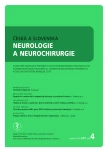Levels of D-dimers in patients with acute ischaemic stroke
Authors:
D. Školoudík 1,2; M. Bar 1; O. Zapletalová 1; K. Langová 3
; R. Herzig 2; P. Kaňovský 2
Authors place of work:
Neurologická klinika FNsP Ostrava-Poruba, Ostrava
1; Iktové centrum Neurologické kliniky LF UP a FN Olomouc
2; Oddělení biometrie Ústavu lékařské biofyziky LF UP Olomouc
3
Published in the journal:
Cesk Slov Neurol N 2007; 70/103(4): 375-379
Category:
Původní práce
Výsledky byly prezentovány formou přednášky na XXXII. slovensko-českém neurovaskulárním sympoziu 11. 6. 2005, Nitra, Slovenská republika.
Summary
Introduction:
D-dimers belong among the basic laboratory indicators of the activity of the fibrinolytic system. The objective of the prospective study was to find out whether an increase in the level of D-dimers in the acute phase of an ischaemic stroke and their dependence on the type, ethiopathogenesis, place of occlusion and risk factors can be detected.
Material and methods:
165 patients with acute central neurological symptomatology were consecutively included in the study in the course of 12 months, all of them having been admitted to the clinic within 6 hours after the occurrence of symptoms. 143 patients were diagnosed with cerebrovascular accident (CVA). A neurological examination, a brain CT and laboratory analyses (blood count, biochemical and coagulation examination including D-dimer levels) were performed in all patients upon admission. All patients underwent a neurosonological examination or a CT angiography upon admission, which were also performed within 6, 24 and 72 hours from the occurrence of symptoms in the patients who had suffered an ischaemic cerebrovascular event.
Results:
The input value of D-dimers was significantly higher in patients with trunk occlusion of an artery of the circle of Willis than in patients with occlusion of minor branches of cerebral arteries, occlusion of the carotid artery or in patients without detectable arterial occlusion, and in patients with ischaemic heart disease, chamber fibrillation and brain infarctions of cardioembolic etiology (p < 0.05). There was no significant difference in terms of levels of D-dimers and fibrinogen between patients with a atherothrombotic and lacunar infarction, a TIA or a haemorrhagic CVA and those with a different etiology of an acute neurological deficit (p > 0.05). The input levels of D-dimers and fibrinogen were not in correlation with the time of recanalisation of the cerebral artery.
Conclusion:
Significantly higher levels of D-dimers can be detected in patients with an ischaemic CVE of cardioembolic etiology, but single examination is of limited value in clinical practice due to large interindividual variablilty.
Key words:
D-dimers – cerebrovascular event – recanalisation of artery – fibrinolytic system
Zdroje
1. Kalvach P. Mozkové ischemie a hemoragie. 2. ed. Praha: Grada Publishing 1997: 59–112.
2. Bogousslavsky J. Acute stroke treatment. London: Martin Dunitz 1997: 33–257.
3. Molina CA, Saver JL. Extending Reperfusion Therapy for Acute Ischemic Stroke. Emerging Pharmacological, Mechanical, and Imaging Strategie. Stroke 2005; 36: 2311-2320.
4. Dunn KL, Wolf JP, Dorfman DM, Fitzpatrick P, Baker JL, Goldhaber SZ. Normal D-dimer levels in emergency department patients suspected of acute pulmonary embolism. J Am Coll Cardiol 2002; 40: 1475-1478.
5. Hoffmeister HM, Szabo S, Kastner C, Beyer ME, Helber U, Kazmaier S et al. Thrombolytic therapy in acute myocardial infarction: comparison of procoagulant effects of streptokinase and alteplase regimens with focus on the kallikrein system and plasmin. Circulation 1998; 98: 2527-2533.
6. Eggebrecht H, Naber CK, Bruch C, Kroger K, von Birgelen C, Schmermund A et al. Value of plasma fibrin D-dimers for detection of acute aortic dissection. J Am Coll Cardiol 2004; 44: 804-809.
7. Kelly J, Rudd A, Lewis RR, Coshall C, Parmar K, Moody A et al. Screening for proximal deep vein thrombosis after acute ischemic stroke: a prospective study using clinical factors and plasma D-dimers. J Thromb Haemost 2004; 2: 1321-6.
8. Barber M, Langhorne P, Rumley A, Lowe GD, Stott DJ. Hemostatic function and progressing ischemic stroke: D-dimer predicts early clinical progression. Stroke 2004; 35: 1421-5.
9. Ageno W, Finazzi S, Steidl L, Biotti MG, Mera V, Melzi D’Eril G, Venco A. Plasma measurement of D-dimer levels for the early diagnosis of ischemic stroke subtypes. Arch Intern Med 2002; 162: 2589-2593 .
10. Kataoka S, Hirose G, Hori A, Shirakawa T, Saigan T. Activation of thrombosis and fibrinolysis following brain infarction. J Neurol Sci 2000; 181: 82-88.
11. Lip GY, Blann AD, Farooqi IS, Zarifis J, Sagar G, Beevers DG. Sequential alterations in haemorheology, endothelial dysfunction, platelet activation and thrombogenesis in relation to prognosis following acute stroke: The West Birmingham Stroke Project. Blood Coagul Fibrinolysis 2002; 13: 339-347.
12. Berge E, Friis P, Sandset PM. Hemostatic activation in acute ischemic stroke. Thromb Res 2001; 101: 13-21.
13. Ince B, Bayram C, Harmanci H, Ulutin T. Hemostatic markers in ischemic stroke of undetermined etiology. Thromb Res 1999; 96: 169-174.
14. Kelly J, Rudd A, Lewis RR, Parmar K, Moody A, Hunt BJ. The relationship between acute ischaemic stroke and plasma D-dimer levels in patients developing neither venous thromboembolism nor major intercurrent illness. Blood Coagul Fibrinolysis 2003; 14: 639-645.
15. Wunderlich MT, Stolz E, Seidel G, Postert T, Gahn G, Sliwka U, Goertler M. Duplex Sonography in Acute Stroke Study Group.Conservative medical treatment and intravenous thrombolysis in acute stroke from carotid T occlusion. Cerebrovasc Dis 2005; 20: 355-361.
16. Lowe GD. Fibrin D-dimer and cardiovascular risk. Semin Vasc Med 2005; 5: 387-398.
17. Squizzato A, Ageno W. D-dimer testing in ischemic stroke and cerebral sinus and venous thrombosis. Semin Vasc Med 2005; 5: 379-386.
18. Rumley A, Emberson JR, Wannamethee SG, Lennon L, Whincup PH, Lowe GD. Effect of older age on fibrin D-dimer, C-reactive protein, and other hemostatic and inflammatory variables in men aged 60-79 years. J Thromb Haemostat 2006; 4: 982-987.
Štítky
Dětská neurologie Neurochirurgie NeurologieČlánek vyšel v časopise
Česká a slovenská neurologie a neurochirurgie

2007 Číslo 4
Nejčtenější v tomto čísle
- Cervikální dystonie
- Hladina D-dimerů u pacientů s akutní ischemickou cévní mozkovu příhodou
- Trombóza esovitého splavu – současný pohled na diagnostiku a léčbu
- Repetitivní transkraniální magnetická stimulace a chronický subjektivní nonvibrační tinnitus
